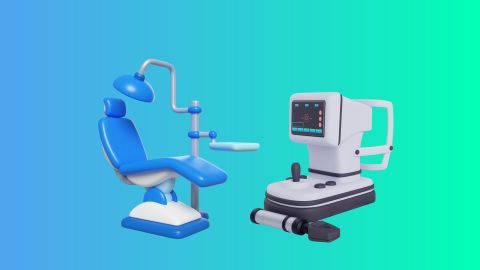If you are considering investing in one, check your MEF eligibility to explore flexible financing options tailored to your practice needs.
How does an intraoral scanner work?
Intraoral scanners function by using optical scanning technology, such as structured light or lasers, to capture detailed images of the oral cavity. These images are stitched together by software to create a 3D digital impression.- Scanning – A dentist moves a handheld device inside the patient’s mouth to scan different angles of the teeth and gums.
- Light projection – The scanner emits light (often structured light or laser) that bounces off the surfaces inside the mouth.
- Image capture – Sensors and internal cameras capture this reflected light, recording thousands of frames per second.
- 3D modelling – The captured data is processed into a precise 3D digital image in real time, visible on a connected screen.
- Editing and saving – The digital impression can be refined, saved, and reused for further procedures like crowns, aligners, or implants.
- Data transmission – The final file can be instantly shared with dental labs or CAD/CAM systems for designing restorations or appliances.
Types of intraoral scanners
Intraoral scanners come in various types to cater to different clinical setups, workflow preferences, and budget levels. Selecting the right type of scanner depends on how the device will be used within the clinic and its level of integration with other dental technologies.- Wired intraoral scanners – These scanners connect to a computer via USB. They are cost-effective, ideal for static use in a dental operatory, and suitable for smaller practices.
- Wireless intraoral scanners – These offer more flexibility in movement and reduce cable clutter. They are more expensive but enhance the operator’s comfort and scanning ease.
- Cart-based scanners – These come with an integrated workstation, monitor, and software suite. Ideal for multi-operatory clinics and larger practices with dedicated scanning areas.
- Standalone handheld scanners – Compact and portable, these are suitable for travelling dentists or clinics with limited space. They typically require a laptop or tablet for display.
- CAD/CAM-integrated scanners – These are designed to work seamlessly with in-clinic milling machines and design software, enabling same-day dentistry like crowns or veneers.
Benefits of using an intraoral scanner
Using an intraoral scanner offers a wide range of clinical, operational, and patient-focused benefits. For Indian dental professionals, these devices represent a significant upgrade over conventional impression techniques, helping to improve patient trust and increase treatment precision.- Enhanced patient comfort – Eliminates messy impression materials and reduces patient discomfort, especially for those with gag reflex.
- Greater accuracy – Produces precise digital models, reducing human error and improving the fit of crowns, bridges, and aligners.
- Faster procedures – Significantly cuts down on chairside time, allowing more patients to be treated each day.
- Real-time feedback – Allows dentists to view and adjust the scan immediately, ensuring high-quality impressions without the need for retakes.
- Digital storage and sharing – Scans can be saved electronically and shared instantly with labs, improving workflow efficiency.
- Eco-friendly – Reduces the need for disposable impression trays and materials, supporting sustainable clinical practices.
- Improved communication – Dentists can visually explain treatment plans to patients using real-time 3D visuals, increasing case acceptance.
Intraoral scanner price in India
The price of intraoral scanners in India varies widely depending on the brand, features, integration capabilities, and support options. While entry-level models are suitable for basic procedures, advanced CAD/CAM-integrated systems and AI-powered scanners offer higher precision and automation. Below is a general pricing guide:| Type of intraoral scanner | Price range (Approximate) |
| Basic wired intraoral scanner | Rs. 2,50,000 – Rs. 4,50,000 |
| Wireless intraoral scanner | Rs. 5,00,000 – Rs. 9,00,000 |
| CAD/CAM-integrated scanner | Rs. 8,00,000 – Rs. 15,00,000 |
| Cart-based scanner with monitor setup | Rs. 10,00,000 – Rs. 18,00,000 |
| High-end AI-powered scanner | Rs. 15,00,000 – Rs. 25,00,000 |
Prices may vary based on accessories, software licences, and warranty packages offered by suppliers.
If you are looking at premium models, do not forget to check your pre-approved MEF offer to get faster access to funds.
Things to consider before buying an intraoral scanner
Purchasing an intraoral scanner is a major investment that must be made after thorough evaluation. Several technical and operational factors must be reviewed to ensure long-term value and compatibility with your practice.- Accuracy and speed – Choose a scanner that offers high-resolution imaging and rapid data processing for faster workflows.
- Software compatibility – Ensure the scanner works well with your existing dental software or CAD/CAM systems.
- Ease of use – Look for intuitive interfaces and ergonomic design that reduce staff learning curve and scanning fatigue.
- Portability – Depending on your space, decide between compact handheld or larger cart-based units.
- Training and onboarding – Select a supplier who provides training, demonstrations, and technical support during setup.
- After-sales support – Ensure service centres and support teams are available locally for repairs and maintenance.
- Warranty and upgrades – Review warranty duration and availability of future software or hardware upgrades.
Maintenance tips for intraoral scanner
Regular maintenance helps extend the life of the intraoral scanner and ensures consistent, safe, and hygienic performance. Poor upkeep may lead to inaccuracies or even equipment damage.- Daily cleaning – Use alcohol-based disinfectant wipes to clean the scanner tip and body after each use.
- Proper storage – Keep the scanner in a dry, dust-free environment and use protective covers when not in use.
- Avoid physical damage – Handle the scanner gently, avoid dropping it, and follow manufacturer handling instructions.
- Calibrate regularly – Use in-built tools or technician assistance to calibrate the scanner for optimal precision.
- Update software – Regularly install firmware and software updates to access the latest features and security fixes.
- Professional servicing – Schedule periodic inspections by authorised service teams for internal cleaning and system checks.
Financing options for intraoral scanner
High-quality intraoral scanners can be costly, especially for smaller or newly established clinics. However, financial support through medical equipment finance by Bajaj Finserv makes it easier to afford these technologies. This financing option offers:- Flexible EMIs – Spread the cost over 12 to 84 months based on your cash flow.
- Quick approval – Minimal documentation and rapid processing help you procure the scanner faster.
- High loan amounts – Sufficient funding to cover premium scanners, accessories, and software.
- Pre-approved offers – Existing Bajaj Finserv customers may get personalised deals for quicker access.
- Improved cash management – No need to dip into operational funds or halt clinic upgrades.
Conclusion
Intraoral scanners are redefining the standards of dental care across India. By offering superior precision, patient comfort, and digital efficiency, they have become essential tools for modern dental practices. Whether you are running a solo clinic or a multi-chair practice, investing in an intraoral scanner boosts clinical output and patient satisfaction. If budget is a concern, consider medical equipment finance to fund your scanner acquisition. For broader expansion plans, a doctor loan can support other infrastructural or technological upgrades, ensuring your clinic remains future-ready.Check your doctor loan eligibility now and secure quick funds.




